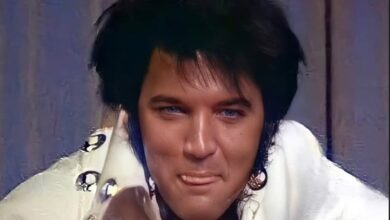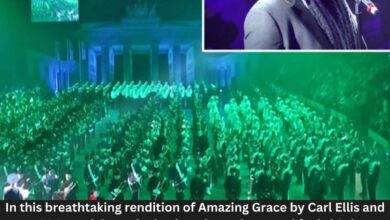Elvis Presley’s ‘It’s Now or Never’ (1960): The King’s Bold Reinvention That Shattered Boundaries
By 1960, Elvis Presley had already conquered rock and roll, but with It’s Now or Never, he reached a new pinnacle of artistic ambition and global influence. Released in July of that year, the song was unlike anything he had recorded before—a sweeping, operatic ballad inspired by Italian music, blending rock, pop, and classical influences in a way that few artists had dared attempt. It became an instant sensation, topping the Billboard Hot 100 for five weeks and dominating charts in the UK, Australia, and across Europe. This song not only marked Elvis’ return to civilian life after his military service but also redefined what rock and roll could be, showcasing his ability to transcend genres and captivate an even broader audience.
Elvis’ musical journey had begun in the raw, electrified energy of early rockabilly, but his influences were always broader. Born in Tupelo, Mississippi, and raised in Memphis, he had absorbed everything from gospel and rhythm and blues to country and big-band crooners. By the time It’s Now or Never was conceived, he was already the undisputed King of Rock and Roll. But with this track, he reached back even further into musical history, embracing a European sound that showcased his vocal evolution. It was a risk, but one that only an artist of his stature could take—and turn into a massive triumph.
The origins of It’s Now or Never trace back to the early 1900s with the Italian classic ’O Sole Mio, composed by Eduardo di Capua. Elvis had first heard the melody while stationed in Germany during his military service from 1958 to 1960. He was enamored with the song’s dramatic, heart-wrenching melody and asked his music publishers, Aaron Schroeder and Wally Gold, to create English lyrics that would fit the tune. What they delivered was a passionate, urgent plea of love—its title and theme perfectly matching Presley’s smoldering vocal delivery. The transformation from a Neapolitan classic to a modern pop hit was seamless, proving Elvis’ instincts about music’s universal appeal were spot on.
The recording of It’s Now or Never took place in April 1960 at RCA Studio B in Nashville, just after Presley’s return from the Army. Producer Steve Sholes and engineer Bill Porter crafted a lush, almost cinematic soundscape for the song. The instrumentation leaned heavily on a rolling, romantic arrangement with Floyd Cramer’s piano, Boots Randolph’s saxophone, and Chet Atkins’ smooth guitar work providing the perfect accompaniment to Elvis’ operatic vocals. The recording was a departure from his raw, rockabilly roots, requiring him to push his voice into a more dramatic, controlled performance. His deep, resonant delivery reflected a maturity and sophistication that many critics at the time had not expected from him.
Upon release, the song was an immediate commercial juggernaut. It debuted at No. 1 in the U.S. and stayed atop the Billboard Hot 100 for five weeks. In the UK, it was even more dominant, remaining at the top for eight weeks and becoming the biggest-selling single of Presley’s career in that region. Internationally, It’s Now or Never cemented Elvis’ status as a truly global artist, proving that his appeal stretched beyond the rock and roll crowd and into the realm of adult contemporary listeners who had previously dismissed his music as teenage rebellion.
The success of It’s Now or Never was pivotal not just for Elvis but for pop music at large. It blurred the lines between classical, pop, and rock, making way for other genre-bending hits in the decades to come. Its operatic influences paved the way for artists like Roy Orbison, who would employ similarly dramatic vocal deliveries in his own ballads. It also redefined the expectations of what a pop singer could be—Elvis was no longer just a rock and roller; he was now an all-around performer, equally adept at crooning as he was at belting out high-energy anthems.
For Presley himself, the song marked a turning point in his career. It expanded his repertoire and made him an even more bankable star. He followed it with similarly dramatic ballads, such as Are You Lonesome Tonight?, reinforcing his ability to command softer, more emotional material. The overwhelming success of It’s Now or Never also inspired him to explore more ambitious musical directions in his film career, leading to a greater emphasis on soundtracks featuring a wider range of styles.
The song’s influence extended beyond Elvis, inspiring countless covers and reinterpretations. Legendary opera singer Mario Lanza, whose recordings had originally influenced Presley’s singing style, later performed ’O Sole Mio in a way that mirrored Presley’s adaptation. Artists ranging from Engelbert Humperdinck to John Schneider have recorded their own versions of It’s Now or Never, and even Luciano Pavarotti paid tribute to Elvis by blending his operatic roots with the song’s pop arrangement.
Beyond its artistic and commercial impact, It’s Now or Never also coincided with a crucial moment in Elvis’ life. It was his first major hit after returning from the Army, marking his transition from rebellious heartthrob to a more mature, polished entertainer. Though he would still deliver rock and roll hits, this song signaled a new phase—one in which he would command the adult market just as easily as he had captivated teenagers.
Over the decades, It’s Now or Never has remained a defining track in Presley’s catalog. It is frequently ranked among his greatest songs, included in numerous best-of compilations, and still receives frequent radio play. The song’s sweeping melody and universal themes of love and urgency have kept it relevant for generations. Its enduring popularity was further solidified when it was re-released in the UK in 2005, where it once again charted, proving its timeless appeal.
Musically, It’s Now or Never helped lay the foundation for future pop ballads that fused classical elements with contemporary styles. It also established the precedent that rock stars could successfully tackle multiple genres without losing credibility. Its cross-generational success showed that music didn’t have to be confined to specific demographics, broadening the scope of what a hit song could achieve.
Even posthumously, the song remains a symbol of Presley’s ability to innovate and take risks. Whether through tribute performances, film soundtracks, or nostalgia-driven revivals, It’s Now or Never continues to capture the imagination of listeners worldwide. It is not just a testament to Elvis Presley’s vocal prowess, but also to his unparalleled ability to reshape and redefine popular music.
More than six decades later, the song stands as an essential chapter in Elvis Presley’s remarkable legacy. It was a moment where rock and roll met classical grandeur, where youthful passion met mature artistry, and where Elvis proved that he was not just the King of Rock and Roll, but a musical force beyond classification.



